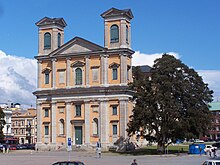Friedrichskirche (Karlskrona)
The Friedrichskirche (Swedish: Fredrikskyrkan ) is a church building in the Swedish city of Karlskrona . It counts with other selected buildings in the city and the naval port for World Heritage of UNESCO .
The building
The construction of the church, which stands on the central square ( Stortorget ) of Karlskrona, began on September 9, 1720. The then head of the provincial government of Blekinge , Salomon von Otter , laid the foundation stone . The foundation walls were finished on August 25 of the following year, but it was not until 1744 that the church could be consecrated. Crown Prince Adolf Friedrich was present at the opening , but the church was named after Friedrich I. The church towers, which were initially supposed to have pointed roofs, were not completed before 1758. The Friedrichskirche is a typical baroque building designed by the architect Nicodemus Tessin the Elder. J. was designed. It replaced the town's temporary wooden church, which was named after Queen Hedwig Eleonora of Schleswig-Holstein-Gottorf . In 1790 the church was damaged in a fire, which was less devastating than the neighboring Holy Trinity Church . In 1805 and 1806 the church was restored by the architect Olof Tempelman .
Further restorations took place in 1913–1915 and 1967–1968 (inside) and 1997–1998 (facade).
Furnishing
Baptismal font, altar, pulpit
The baptismal font is carved from wood and was given to the parish by shipbuilder Gilbert Sheldon for the inauguration of the church. The neoclassical pulpit was built in 1854 according to plans by the architect Johan Adolf Hawerman (1812–1885). The altarpiece is significantly younger, it was created in 1915 as a neo-baroque altar with sculptures by JA Wetterlund.
In the south tower there has been a carillon with 35 bells that were cast in Sigtuna since 1967 . The carillon is played three times a day and was a gift from the lawyer Povel Grönvall. The church silver is kept in a massive safe, which is located under the left grandstand in the front part of the church.
Organs
The first organ was taken over from the temporary wooden church. The organ builder Lars Wahlberg was later commissioned to produce an organ with 29 voices , 2 manuals and a pedal . When the organ was finished in 1764, the number had increased to 34 voices, which were operated with 6 large bellows .
|
|
|
|||||||||||||||||||||||||||||||||||||||||||||||||||||||||||||||||||||||||||||||||||||||||||||||||||||||||||||||||||||||||||||||||||||||||||||||||
- Pairing : II / I
Wahlberg's organ was replaced in 1905 by a romantic-style organ, but after the reconstruction between 1982 and 1987, Wahlberg's organ was used again. In 1988 the organist Hans Fagius recorded works by JS Bach on the Wahlberg organ. The recordings are available on CD.
gallery
Individual evidence
- ↑ Information on the organ ( Memento from August 9, 2014 in the Internet Archive ) (PDF file; 154 kB)
Web links
Coordinates: 56 ° 9 ′ 40 ″ N , 15 ° 35 ′ 16 ″ E




